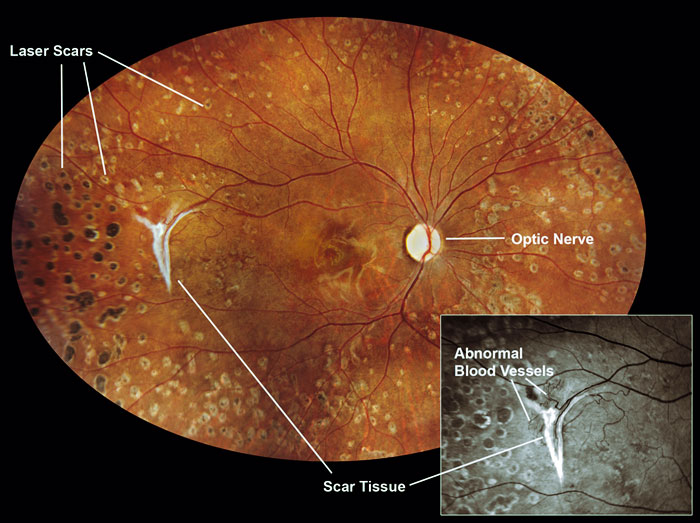Lupus (Systemic Lupus Erythematosus) Treatment of the Retina

Fort Collins Optometrist-Lupus Eye Picture
This photograph is from the National Eye Institute, courtesy of NEI staff clinician H. Nida Sen, M.D., M.H.Sc., clinical fellow Chloe Gottlieb, M.D., F.R.C.S.C., and ophthalmic imaging specialist Michael Bono, B.A., C.R.A., C.O.T.
Systemic lupus erythematosus (SLE) is a disease that is commonly referred to as Lupus. It is an autoimmune disease where the bodies immune system malfunctions and attacks its own cells and tissues. It can attack almost any organ in the body with the skin, kidneys, heart, lungs, blood vessels, joints, and brain common targets. A common mnemonic or rhyme used in the past to describe Lupus was “hocus pocus out of focus systematic erythematosus.” That sums up the difficulty in diagnosing a disease that can effect almost any organ in the body. More common in middle aged women, Lupus can be treated with a variety of medications.
The eye has complications from Lupus in about 1 of every 5 patients. Occasionally eye problems may be the first signs of Lupus. The eyelids may lose lashes and swell on top where the lacrimal gland that secretes tears is located. Dry eyes from damage to the lacrimal gland can lead to complications on the cornea, the clear tissue on the front of the eye. Inflammation of the sclera (the white tissue of the eye) or uveitis (inflammation inside the eye) may occur.
The immune system can form deposits in the blood vessels in the back of the eye blocking the blood flow and causing damage to the retina, the tissue we see with that lines the back of the eye. The damage occurs from the oxygen deprivation that happens when the blood flow is restricted. The lack of oxygen causes the eye to produce a protein called vascular endothelial growth factor that causes neovascularization, or the growth of fragile new blood vessels. These blood vessels rupture and bleed, resulting in vision loss.
In the photograph you can see a central round white circle where the optic nerve enters the back of the eye. The red branching lines are the normal blood vessels that supply the retina. There are numerous small white spots, some with black centers. These are areas where the retinal tissue has been destroyed by treatment with multiple laser burns. Since they are all off of the central line of sight there is no noticeable loss of sight from this treatment. They do reduce the amount of tissue and therefore the overall demand for oxygen. The patient also received an eye injection of a drug that blocks the production of the vascular endothelial growth factor. The final result was to stop the growth of the fragile blood vessels and prevent the loss of vision. There is a V shaped white area that is where the blood vessels had been proliferating and now it has become scar tissue.
Lupus is a complex disease that requires careful treatment, and even the medications used in treating the disease need to be monitored as they can cause eye problems by themselves.
Comments 3
I have lupus and RA and also a diabetic , I have several problems with my eyes first having blurred vision and dryness with a lot of pressure feeling like my eye is popping out , went to an eye specialisit and he can;t seem to find out what’s wrong, he see some problems with my retina but not enough to really diagnose , but what is this going to lead too…….He also did a pressure test, and that came out normal, but with my history all test seem to come back normal or really not showing anything, its hard cause I don’t want drs to seem like I a sicky but when no one know what wrong and you have to keep going and going to different drs for help all the time…….My family drs the greatest he really get too the problems I wish every drs can be like him!!! I was also dx with tb and was treated for it and now my rheumalogist can start me on any Iv med cause of my past history and day by day I live with the pain, so I hope someday a cure can be found…..Thanks for looking.
Author
Autoimmune diseases can be so wearing an hard. If you haven’t investigated alternative medicine or Complimentary Alternative Medicine (CAM) as it is sometimes referred to you might ask your family Doc for recommendations. Low dose antidepressant medications can also be a godsend for some people with chronic pain problems (not due to the antidepressant effect) so I would ask about that also. Pain is often very under treated and results in chronic depression. The RA may be causing dry eye and other symptoms. There are lots of tests for dry eyes but none are really good. If they feel dry and sting you probably have dry eyes. Find someone who will try treating it. Ask your family Doc about trying Omega 3-it could help the dry eye and the RA, it just takes a few months.
Lupus causes it to assault normally functioning, healthy tissues. Symptoms are: inflammation and harm to the joints, skin, blood, heart, lungs and kidneys etc. It has severe effects like: kidney damage, breathing distress. To prevent it, one should lead healthy lifestyle, have balanced diet, do regular low intensity exercise, one should always seek doctors consultation.